Topics
Category
Era
Paul Bunyan (folklore character)
Paul Bunyan artwork by William B. Laughead, 1922. From the title page of The Marvelous Exploits of Paul Bunyan (Minneapolis: Red River Lumber Company, 1922).
The giant lumberjack Paul Bunyan—bearded, ax in hand, clad in red flannel and work boots—has come to represent Minnesota’s Northwoods. Folklore credits him and his sidekick, Babe the Blue Ox, with creating the Mississippi River and the Grand Canyon. But his legacy is complicated. While Paul Bunyan myths celebrate Minnesota, they also leave out the facts of the state’s logging history, which led to deforestation and the displacement of Native American histories, places, and people.
The stories of Paul Bunyan had their beginnings in the camp stories of North American loggers in the mid-1800s. These stories, shared to build community, entertain, and teach lessons, circulated among Scandinavian (primarily Swedish and Norwegian), German, and Irish immigrants to the upper Great Lakes, including northern Minnesota. The timber cruisers (appraisers) of the Great Lakes, employed by logging companies to survey forests and collect information, played a key role in the spread of Paul Bunyan tales. During the winter of 1885–1886, timber cruisers of Rhinelander, Wisconsin, shared the first Paul Bunyan stories we recognize today.
The first published, though uncredited, account of Paul Bunyan appeared in a Duluth News Tribune article from 1904 that told the story of “the decline of the great American Lumber Jack.” This article references a “series of imaginative tales about the year Paul Bunyan lumbered in North Dakota,” during the year of the “blue snow.”
Then, in 1914, William B. Laughead popularized Paul Bunyan through a promotional pamphlet for the Red River Lumber Company. This pamphlet was reproduced as a second edition in 1916 and as a third edition in 1922, expanding Bunyan’s reach. This first pictorial representation of the Bunyan character, as a corporate mascot of sorts, promoted the company’s move from the Northwoods of Minnesota to Westwood, California.
Only a decade later, in 1925, James Stevens published his best-selling collection of Paul Bunyan tales. The book detailed how Bunyan had rescued a giant blue ox calf (Babe) from a frozen bay and adopted it as a companion. Babe, Bunyan, and a lumberjack crew then traveled around the US, felling trees across an “empty” landscape. Another volume described them creating the Great Lakes (Babe’s footprints), the Mississippi River (water from Bunyan’s tank), and the Red River (tinted by their spilled ketchup). These myths imagined that Minnesota’s waterways were new, and created by immigrants. They displaced Native creation stories, which said that Gichi Manitou (Ojibwe) and Wakaŋ Taŋka (Dakota) had made the rivers and lakes.
By the late 1900s, Paul Bunyan’s legendary figure was marked on the landscape of Minnesota: the 115-mile long Paul Bunyan Trail; the Paul Bunyan State Forest in Hubbard and Cass Counties; Paul Bunyan Land in Brainerd; and Paul Bunyan Mall in Bemidji. Roadside stands, statues, murals, and eateries used his image. As his myth spread, however, it overshadowed the ongoing cost of logging to Minnesota’s people and environment.
Paul Bunyan is credited with logging the “Northwoods,” a vast geography that spans the international border with Canada from New England to the Great Lakes, and west to the Pacific coast. In Minnesota, it was the state’s vast stands of white pine that drew loggers near, far, and fictional. The state’s first sawmill, the Marine Lumber Company, opened on the St. Croix River in 1839, and it was not long before logging made its way north. The “golden days” of logging began.
The loggers who came to northern Minnesota in the mid-1800s found not the empty forests of Bunyan myths but a network of established Ojibwe communities. Lumber companies were able to build their camps only after a series of treaties (1837, 1854, and 1855) transferred prime pinelands away from Ojibwe nations and into the hands of the federal government. Bunyan stories also leave out the destruction that followed. The state’s vast pine forests were depleted by 1930, and lumber companies moved out of the state. Clearcutting left woodlands vulnerable to uncontrolled burning, leading to disasters like the Cloquet Fire of 1918. And dams created by loggers destroyed so many wild rice beds in north-central Minnesota that the Bois Forte Ojibwe had to abandon their homes.
The Native people who shaped the state’s logging history—as workers, residents, and land stewards—are missing from Bunyan lore. While Bunyan’s fictional crew is European American, Native men also labored in logging camps. Logging was exhausting and dangerous work. Yet it allowed many Native workers to enter the wage economy and remain close to their homelands. Other Native people, meanwhile, created Paul Bunyan tales of their own. By the late 1900s, Ojibwe storytellers explained the preservation of forests at Red Lake by saying that Bunyan had lost a fight with Nanabozho, the mythical Ojibwe trickster hero who predated him.
Bibliography
Brown, Charles E. American Folk Lore: Paul Bunyan Tales. Madison, WI: University of Wisconsin, 1922.
——— . Paul Bunyan Tales: Tall Yarns of the Mythical Hero of the American Lumber Camps. Madison, WI: C. E. Brown, 1929.
“Caught on the Run.” Duluth News Tribune, August 4, 1904.
Kinnear, Craig William. “The Legend of Logging: Timber Industry Culture and the Rise of Paul Bunyan, 1870–1945.” PhD diss., University of Notre Dame, 2016.
Laughead, William B. The Marvelous Exploits of Paul Bunyan. Minneapolis: Red River Lumber Company, 1922.
https://archive.org/details/marvelousexploit00laugiala
Edmonds, Michael. Out of the Northwoods: The Many Lives of Paul Bunyan. Madison, WI: Wisconsin Historical Society Press, 2009.
Forester, Jeff. The Forest for the Trees: How Humans Shaped the North Woods. St. Paul: Minnesota Historical Society, 2004.
Gross, Lawrence W. “Cultural Sovereignty and Native American Hermeneutics in the Interpretation of the Sacred Stories of the Anishinaabe.” Wíčazo Ša Review 18, no. 2 (Autumn 2003): 127–134.
Keeler, Kasey, and Ryan Hellenbrand. “Paul Bunyan and Settler Nostalgia in the Northwoods.” Edge Effects, December 2, 2021.
https://edgeeffects.net/paul-bunyan-narratives
Peacock, Thomas, and Marlene Wisuri. Ojibwe: Waasa Inaabidaa: We Look in All Directions. St. Paul: Minnesota Historical Society Press, 2002.
Shepherd, Esther. Paul Bunyan. New York: Harcourt, Brace, 1924.
Stevens, James. Paul Bunyan. New York: Knopf, 1947.
https://babel.hathitrust.org/cgi/pt?id=inu.39000005928127
Westerman, Gwen, and Bruce White. Mni Sota Makoce: The Land of the Dakota. St. Paul: Minnesota Historical Society, 2012.
Wisconsin Historical Society. Paul Bunyan: America’s Best-Known Folk Hero. https://www.wisconsinhistory.org/Records/Article/CS504
Related Resources
Primary
Folklore pamphlets of Charles E. Brown, 1921–1945
Pamphlets Collection, Wisconsin Historical Society, Madison
Description: Extensive collection of stories from and about the state of Wisconsin including those on Native Americans, loggers, and local history.
https://content.wisconsinhistory.org/digital/collection/tp/id/38931
Paul Bunyan collection
Children’s Literature Research Collections, University of Minnesota, Minneapolis
Description: Extensive collection of Paul Bunyan materials, including original manuscripts, pamphlets, photographs, newspaper clippings, and memorabilia.
https://archives.lib.umn.edu/repositories/4/resources/5795
Secondary
Hennigar, Mary Jane. “The First Paul Bunyan Story in Print.” Journal of Forest History 30, no. 4 (October 1986): 175–181.
https://foresthistory.org/wp-content/uploads/2019/09/FirstPaulBunyanStory.pdf
MacGillivray, James. “The Round River Drive.” Detroit News Tribune, June 24, 1910.
“Paul Bunyan’s Famous Lumber Camp, a Myth Known to Old-Time Woodsmen.” Duluth Evening Herald, February 1, 1908.
https://www.mnhs.org/newspapers/lccn/sn84024278/1908-02-02/ed-1/seq-18
Schmit, Dean. “They Were Men in Those Days’: Gender, Class, and Ethnicity in the Paul Bunyan Tales.” Honors capstone, University of Minnesota, 2023.
Shepherd, Esther. “The Tall Tale in American Literature.” Pacific Review 2 (December 1921): 402–414 .
Related Audio
MN90: Supersize Me: The Legend of Paul Bunyan
All rights reserved
More Information
Articles
Related Images
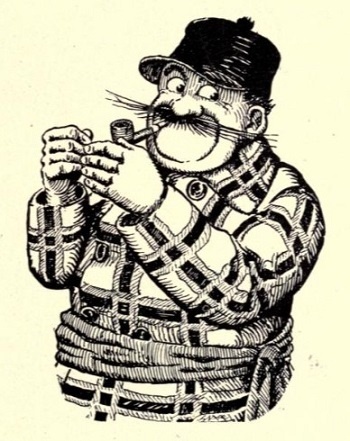
Paul Bunyan artwork by William B. Laughead
Paul Bunyan artwork by William B. Laughead, 1922. From the title page of The Marvelous Exploits of Paul Bunyan (Minneapolis: Red River Lumber Company, 1922).
Public domain
Articles
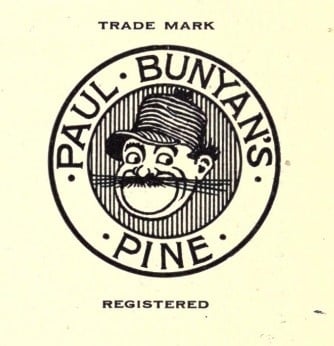
Red River Lumber Company logo
The earliest known visual representation of Paul Bunyan: the logo of the Red River Lumber Company, designed in 1914 by William B. Laughead. From The Marvelous Exploits of Paul Bunyan (Minneapolis: Red River Lumber Company, 1922), 3.
Public domain
Articles
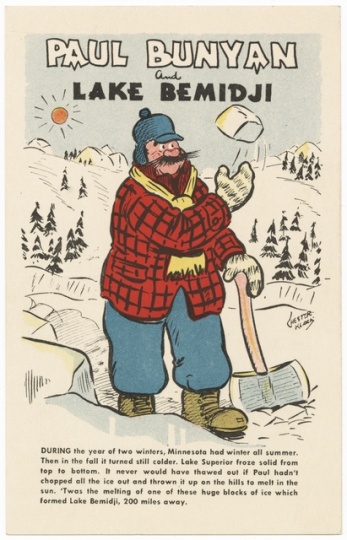
Paul Bunyan postcard
Holding Location
Articles
More Information
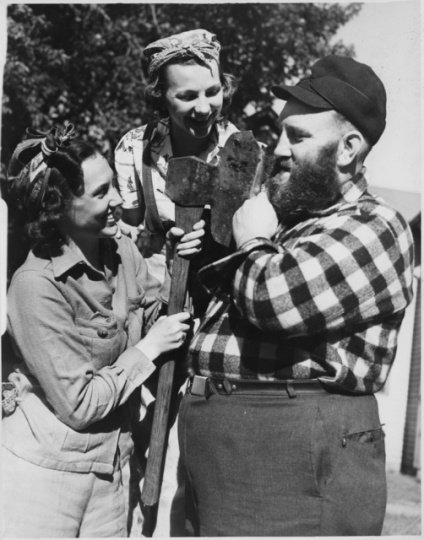
Paul Bunyan Festival participants
Holding Location
Articles
More Information
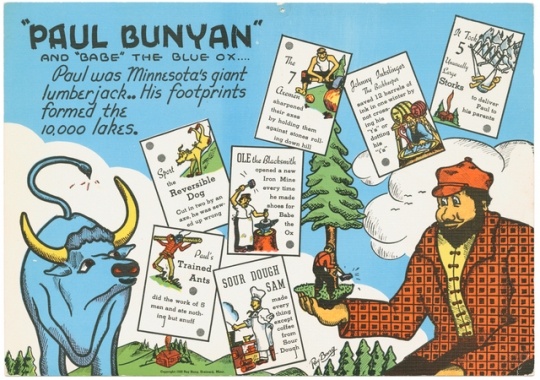
Illustration of Paul Bunyan and Babe the Blue Ox
Holding Location
Articles
More Information
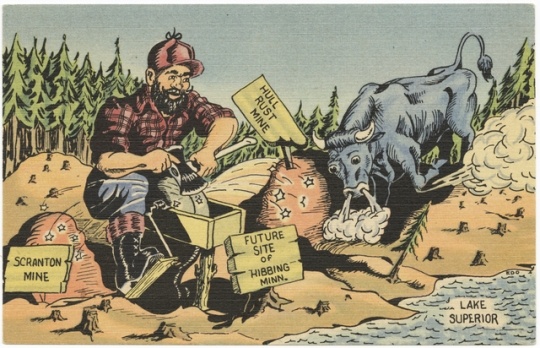
Paul Bunyan and the Iron Range postcard
Holding Location
Articles
More Information
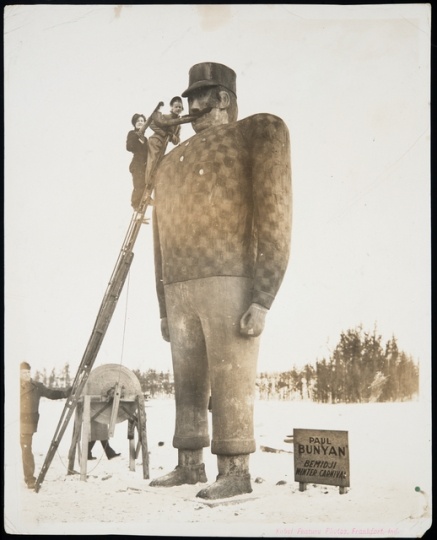
Lighting Paul Bunyan's pipe, 1940s
Holding Location
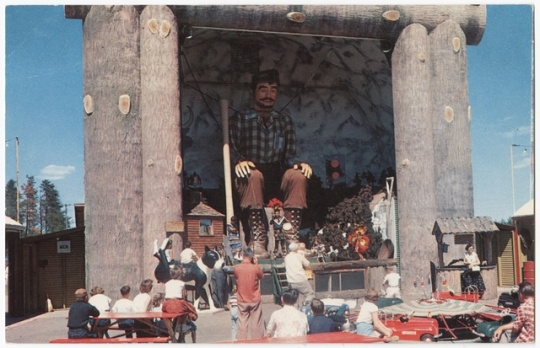
Paul Bunyan Center, Brainerd
Holding Location
Articles
More Information
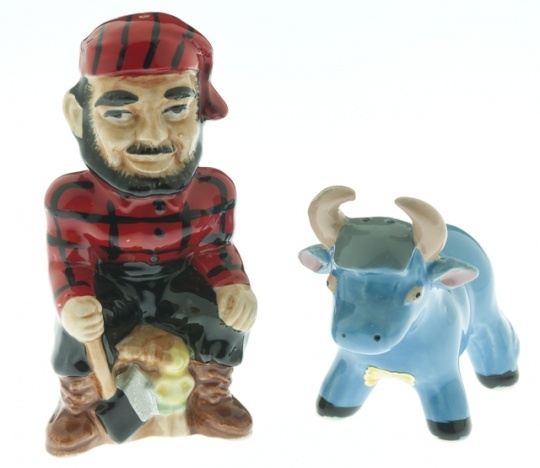
Paul Bunyan and Babe salt-and-pepper shakers
All rights reserved
Holding Location
Articles
More Information
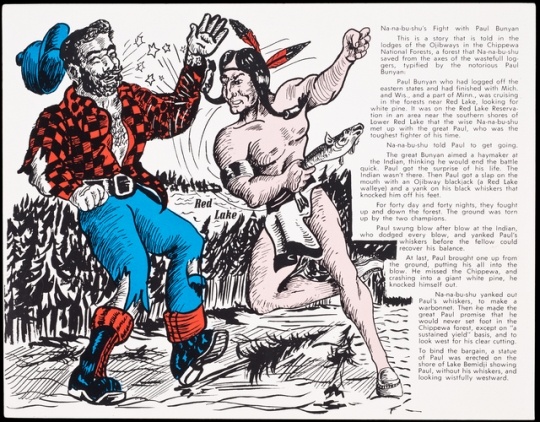
Postcard illustration of Nanabozho fighting with Paul Bunyan
Holding Location
Articles
More Information
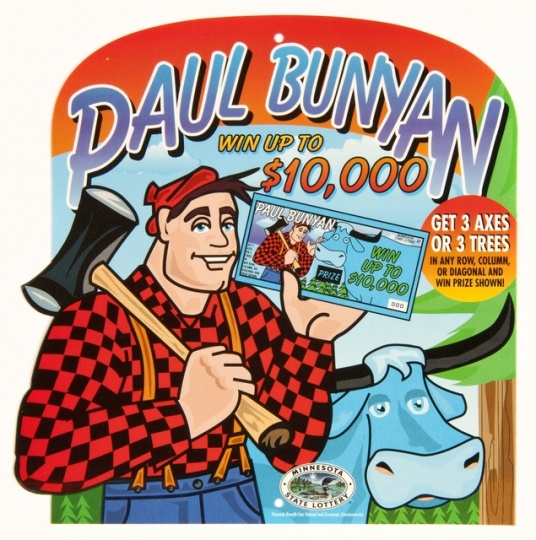
Paul Bunyan lottery game sign
Holding Location
Articles
More Information
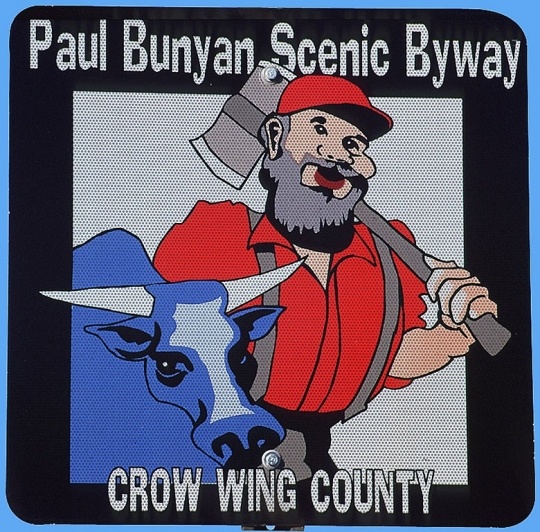
Paul Bunyan Scenic Byway sign
Public domain
Holding Location
Articles
More Information
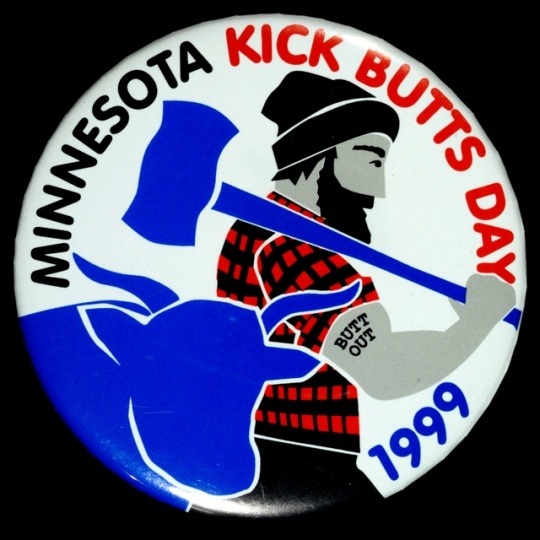
“Minnesota Kick Butts Day” button
All rights reserved
Holding Location
Articles
More Information
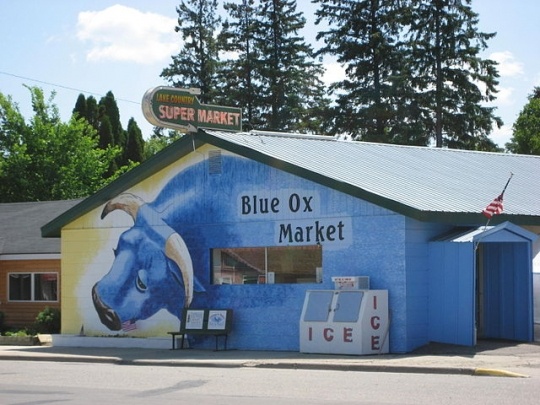
Blue Ox Market, Akeley
Holding Location
Articles
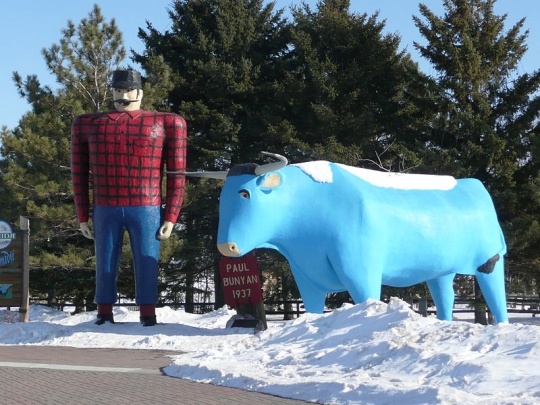
Paul Bunyan and Babe the Blue Ox statues in Bemidji
Holding Location
Articles
More Information
Related Articles
Turning Point
In 1914, William B. Laughead publishes a pamphlet to advertise the Red River Lumber Company’s move from Minnesota to California. The pamphlet includes the first documented image of Paul Bunyan as a folklore character.
Chronology
1837
1839
1854
1855
1884
1885
1892
1914
1916
1925
1929
1937
1950
1984
2006
Bibliography
Brown, Charles E. American Folk Lore: Paul Bunyan Tales. Madison, WI: University of Wisconsin, 1922.
——— . Paul Bunyan Tales: Tall Yarns of the Mythical Hero of the American Lumber Camps. Madison, WI: C. E. Brown, 1929.
“Caught on the Run.” Duluth News Tribune, August 4, 1904.
Kinnear, Craig William. “The Legend of Logging: Timber Industry Culture and the Rise of Paul Bunyan, 1870–1945.” PhD diss., University of Notre Dame, 2016.
Laughead, William B. The Marvelous Exploits of Paul Bunyan. Minneapolis: Red River Lumber Company, 1922.
https://archive.org/details/marvelousexploit00laugiala
Edmonds, Michael. Out of the Northwoods: The Many Lives of Paul Bunyan. Madison, WI: Wisconsin Historical Society Press, 2009.
Forester, Jeff. The Forest for the Trees: How Humans Shaped the North Woods. St. Paul: Minnesota Historical Society, 2004.
Gross, Lawrence W. “Cultural Sovereignty and Native American Hermeneutics in the Interpretation of the Sacred Stories of the Anishinaabe.” Wíčazo Ša Review 18, no. 2 (Autumn 2003): 127–134.
Keeler, Kasey, and Ryan Hellenbrand. “Paul Bunyan and Settler Nostalgia in the Northwoods.” Edge Effects, December 2, 2021.
https://edgeeffects.net/paul-bunyan-narratives
Peacock, Thomas, and Marlene Wisuri. Ojibwe: Waasa Inaabidaa: We Look in All Directions. St. Paul: Minnesota Historical Society Press, 2002.
Shepherd, Esther. Paul Bunyan. New York: Harcourt, Brace, 1924.
Stevens, James. Paul Bunyan. New York: Knopf, 1947.
https://babel.hathitrust.org/cgi/pt?id=inu.39000005928127
Westerman, Gwen, and Bruce White. Mni Sota Makoce: The Land of the Dakota. St. Paul: Minnesota Historical Society, 2012.
Wisconsin Historical Society. Paul Bunyan: America’s Best-Known Folk Hero. https://www.wisconsinhistory.org/Records/Article/CS504
Related Resources
Primary
Folklore pamphlets of Charles E. Brown, 1921–1945
Pamphlets Collection, Wisconsin Historical Society, Madison
Description: Extensive collection of stories from and about the state of Wisconsin including those on Native Americans, loggers, and local history.
https://content.wisconsinhistory.org/digital/collection/tp/id/38931
Paul Bunyan collection
Children’s Literature Research Collections, University of Minnesota, Minneapolis
Description: Extensive collection of Paul Bunyan materials, including original manuscripts, pamphlets, photographs, newspaper clippings, and memorabilia.
https://archives.lib.umn.edu/repositories/4/resources/5795
Secondary
Hennigar, Mary Jane. “The First Paul Bunyan Story in Print.” Journal of Forest History 30, no. 4 (October 1986): 175–181.
https://foresthistory.org/wp-content/uploads/2019/09/FirstPaulBunyanStory.pdf
MacGillivray, James. “The Round River Drive.” Detroit News Tribune, June 24, 1910.
“Paul Bunyan’s Famous Lumber Camp, a Myth Known to Old-Time Woodsmen.” Duluth Evening Herald, February 1, 1908.
https://www.mnhs.org/newspapers/lccn/sn84024278/1908-02-02/ed-1/seq-18
Schmit, Dean. “They Were Men in Those Days’: Gender, Class, and Ethnicity in the Paul Bunyan Tales.” Honors capstone, University of Minnesota, 2023.
Shepherd, Esther. “The Tall Tale in American Literature.” Pacific Review 2 (December 1921): 402–414 .
















